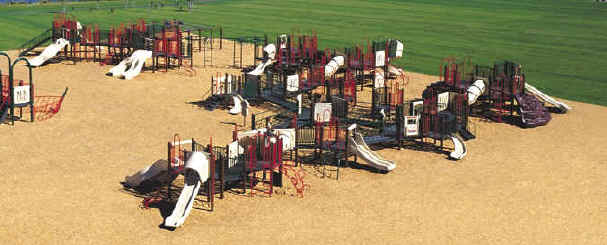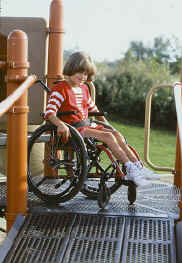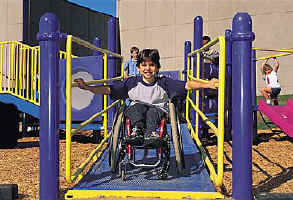When Ramps Are Required
Ramps are required on composite structures with 20 or more elevated play components and must connect to at least 25 percent of the elevated play components. Ramps allow individuals who use wheelchairs and mobility devices to access elevated play components in composite play structures without transferring.
This play area has more than 20 play components and provides ramp access to elevated play components. The ramp system, consisting of ramp runs and landings, must connect at least 25 percent of the elevated play components. The balance of the elevated play components required to be on an accessible route may be connected by the ramp system, or by a transfer system.
Rise of a ramp is the amount of vertical distance the inclined or slanted surface ascends or descends. A ramp run is a length of a continuous sloped surface that is ascending or descending. For example, to reach a 12-inch high deck or platform, a designer could use a 12-foot ramp with the maximum 1:12 slope, or a 14-foot ramp with a less-steep 1:14 slope.
Platform lifts, also known as "wheelchair lifts," may be considered for providing access to elevated play components when appropriate. Where applicable, platform lifts complying with ADAAG section 4.11 and applicable state and local codes are permitted as a part of an accessible route. Because lifts must be independently operable, owners and operators should carefully consider the appropriateness of their use in unsupervised settings.
Ramps
Ramps serve as a continuation of the accessible route from the ground allowing individuals who use mobility
devices to access elevated components. For each elevated ramp run:
-
12-inch (305 mm) maximum rise
-
1:12 maximum slope
-
36-inch (915 mm) minimum clear width
Maneuvering Space Where Ramps are Provided
At least one maneuvering space must be provided on the same level as the play component. The space must have a slope no steeper than 1:48 in all directions. The ADA and ABA Accessibility Guidelines address additional requirements for ramps and landings including edge protection, cross slope, surfaces, and outdoor conditions.
Landings
Landings are the level surfaces at the top and bottom of each ramp run.
-
Must be as wide as the ramp they connect to
-
A minimum length of 60 inches (1525 mm)
-
If ramps change direction, the minimum landing size must be 60 inches (1525 mm) wide to accommodate a turn
Handrails
Handrails are required on both sides of ramps connecting elevated play components. Handrails must comply with the following:
-
Clearance between handrail gripping surfaces and adjacent surfaces shall be 1 1/2 inches (38 mm) minimum.
-
Handrail gripping surfaces shall be continuous along their length and shall not be obstructed along their tops and sides. The bottoms of handrail gripping surfaces shall not be obstructed for more than 20 percent of their length. Where provided, horizontal projections shall occur 1 1/2 inches (38 mm) minimum below the bottom of the handrail gripping surface.
Handrails are required to comply with ADAAG 4.8.5. However, extensions on handrails in the play area are not required. This is to prevent children running into protruding rails in the play area.




User Comments/Questions
Add Comment/Question